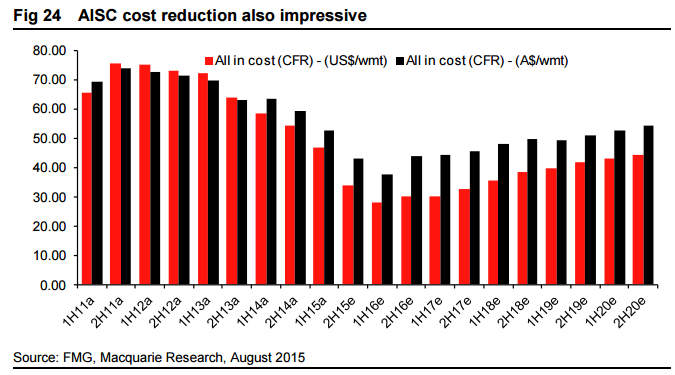From Mac Bank:
We are upgrading our recommendation on FMG from Neutral to Outperform. Material reductions in operating costs, driven by a combination of factors, have significantly improved the earnings outlook for FMG. Currency tailwinds could see cost targets reduced further and we believe FMG is now much better positioned to operate within a volatile iron-ore price environment. A combination of reducing cut-off grades, ramping up Solomon, better than expected performance from the processing plants and changes in product mix have enabled FMG to deliver material reductions in strip ratios, and as a result lower operation costs. Incorporating changes to our forward operating and cost assumptions has translated to a 14% increase in our price target to $2.50.
Breakeven price could fall to US$37/dmt
FMG’s cost out program has been impressive, with C1 cash costs falling from A$51/wmt to A$28/wmt in just 3 years. We believe there are a number of factors behind the impressive cost reduction performance which have reduced FMG’s cash flow breakeven guidance for FY16 to US$39/dmt. A better than expected performance of the processing plant has enabled a reduction in cut-off grades at Cloudbreak and Christmas Creek, while changes in the product mix have also had a positive impact. We believe the bulk of these changes are permanent, and combined with favourable currency movements could see FMG’s cash flow breakeven price fall to US$37/dmt during FY16.
Strip ratio decline a key driver of cost reductions
Like many of its peers, reduced contractor rates, falling oil prices and changes to employee rosters have all been contributors to the cost reduction story. The reduced average strip ratio has grabbed most of the headlines. Whilst we concede that strip ratios will rise from the 4QFY15 average, the reduction in average long-term strip ratios from ~3:1x to ~2:1x can be explained.
Minority sale option could solve debt concerns
At the end of June FMG’s net debt balance was US$7.2bn, split US$2.4bn in cash and US$9.6bn in debt. Our forecasts have FMG’s net debt balance falling 40% to US$4.3bn in three years, with cash flow generation sufficient to meet the current debt repayment schedule. However should iron-ore prices remain below US$50/t over the next three years, FMG would need to refinance its US$4.8bn term loan due in June 2019. In the absence of a refinance, we believe FMG could look to sell a minority interest in its operating mines. Our analysis suggests a 10-15% sale of the Chichester and Solomon mines could raise US$1-2bn.
Could be a good call in the short term. If the iron ore price stays around $50 there is always the chance of a bear market rally to $2.50.
But, given Macquarie does not do any peer-to-peer cost analysis in its report, which is all that matters in the longer term, there’s really nothing here beyond a punt on a bear market rally. We all know FMG is doing a great job of reducing its costs. The question is that after reducing strip ratios from 5:1 to 1:1 can it sustain it over the the longer term. Macquarie itself gives you then answer in the chart: nope. And as FMG costs rise beyond next year, iron ore demand keeps falling and the cost-out war goes on, will FMG become the global marginal cost producer? Yep.
As such, the percentage play here remains selling rallies or building up shorts whenever the patsies dive in on false hope.


